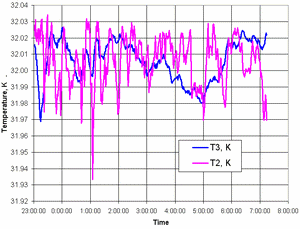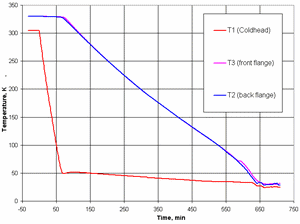Cooling system for Cryo-TPC
The cooling system of the chamber relies on the gravity circulation of the liquid Neon in the closed loop system. Neon is cooled down in the condenser by the coldhead and flows down by copper tubes. Then it comes to the forward and backward heat exchangers on the chamber flanges through the horizontal bellows. Then Neon returns to the condenser from the top part of the heat exchangers.
This is closed loop system with the total volume of Ne necessary for the circulation about 350sl. The system is connected to the external bottle (50 liters volume) and at the normal conditions filled with 7bar Neon pressure. During the cooling and Ne liquefaction pressure drops down to 1-2bar. The system appears to be very safe. In case of emergency heating Neon is simply returned to the bottle with maximum pressure of 7bar.
All parameters of the Musun cryogenic TPC are controlled and measured using modular slow control system based on DAQ32 and AICS modules. The control system measures the pressure of Ne in the system and differential pressure drop in the vertical cooling line. The cooling time – time from the hot chamber (300K) to the working temperature (30K) is about 10-11 hours. Cooling process is shown below. Red line represents coldhead temperature, blue and magenta – two chamber flanges.
The important aspect of the cooling system is that cooling can be performed not only by liquid Neon, but by the cold gas also. Heat transport of cooling power with Neon gas at 50K temperature is about 30-40W. It means that it is possible to stabilize any temperature of the chamber in the range of 30-300K.
Temperature stabilization is performed in 3 points independently:

1. coldhead temperature;
2. temperature of the forward flange of Cryo-TPC;
3. temperature of the back flange of Cryo-TPC.
Temperature is stabilized at the level of 32 with stability of ±0.03K and the reserve of cooling power is about 25W (electrical power which is supplied to the heaters to compensate the cooling). This is very good result and it demonstrates that loss of cooling power for radiation heating, heat transport through vacuum and heat bridges is only 5-8W. Temperature sensors were calibrated at the condition of thermal equilibrium by the vapor pressure of liquid Neon.
